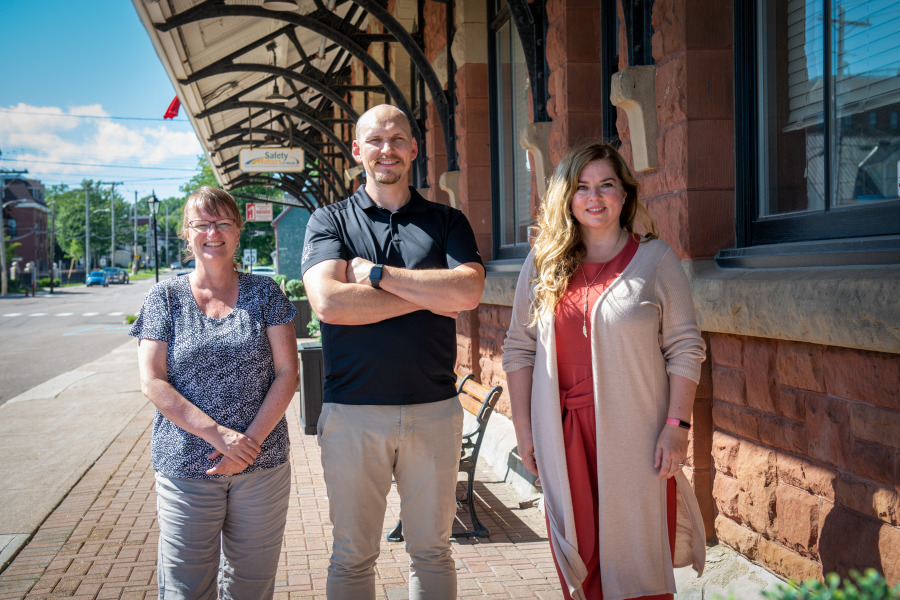New digital map tells the history of transportation in Charlottetown

Active transportation is much in the news these days, but not so many years ago, cities, including Charlottetown, relied primarily on human- and horsepower to move people and goods around.
Dr. Josh MacFadyen, Canada Research Chair in Geospatial Humanities at UPEI, has launched an interactive digital story map of historical transportation in Charlottetown, covering the days of human- and horse-powered transportation to the coming of the automobile.
Titled “By Muscle, Mast, and Motor: A Transportation History of Charlottetown,” the project was created over the last year by MacFadyen and his student Barbara Rousseau, along with other students in his Applied Communications, Leadership, and Culture digital humanities course and the UPEI GeoREACH Lab.
Rousseau, in particular, played a leading role in the project. “In addition to Barbara’s strong skills as a researcher,” MacFadyen said, “she kept the trains running on time.”
Working with the historical maps of Charlottetown, the students helped to georeference and create a mosaic of the full set of 1917 Fire Insurance Plans to act as a base map and a research tool. Georeferencing is the process of adding geographic information to a digital image so that the mapping software known as Geographic Information Systems (GIS) can place the image in its real-world location.
“This story map presents an early transportation history of the City of Charlottetown, the capital of Prince Edward Island, Canada,” said MacFadyen. “It touches on all forms of transportation from early water-based transportation until the advent of the automobile in the interwar period.”
Rich with historical information, photographs, maps, and illustrations, the story map explores the five main ways that people used to travel and transport goods—water, rail, foot and bicycle, and automobile—from the city’s beginnings until the interwar period. It is organized around 80 sites that were either central to, or symbolic of, developments in the history of transportation in the greater Charlottetown area.
Most of those 80 sites have disappeared or changed—some beyond recognition—but they can be explored on the maps accompanying each section of the story map. Each site marker is accompanied by a brief description of what had been there in the past. A well-known example is the red sandstone building on the corner of Weymouth and Water Streets that houses the Workers’ Compensation Board; it was the main passenger station for the PEI Railway, later the Canadian National Railway, from 1907 to 1983. A lesser-known example is the Charlottetown Bicycle and Athletic Grounds, which was established around 1880–1900 close to where Sobey’s is located on Allen Street.
“Charlottetown has experienced several new developments in active transportation in the last generation,” said MacFadyen, “so as people get away from their cars a little, what aspects of Charlottetown will they recognize in these site histories? Understanding the past can help us to determine and shape the kind of city we want to live in.”
MacFadyen enjoyed helping the students learn how to use historical GIS as both a tool for historical analysis and a communication device. Noting that the project was a collaborative effort, he said the class benefitted from guest lectures and ongoing consultation with Natalie Munn, City of Charlottetown Planning and Heritage Department.
“It is important for us to share the rich history of the City of Charlottetown in a variety of ways,” said Munn. “The partnership with UPEI afforded the City the opportunity to share our history, research, and archival collection with the authors and the digital humanities class and in turn, benefit from their technical skills in the production of this story map.”
Both Munn and the City of Charlottetown Archives played a critical role in the research behind most of these site histories, first with the class and later with individual students and ongoing consultation with the authors. The digital exhibit space, Charlottetown Stories: Explore Your City's Heritage, contains additional resources for many of the sites explored in the story map.
The project also relied heavily on information from the PEI Public Archives and Records Office; L’Nuey; Robertson Library; and colleagues in the UPEI history department.